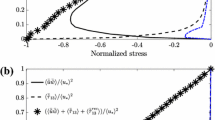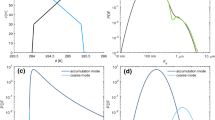Abstract
A computational scheme for an improved Mellor–Yamada(M–Y) Level-3 model with condensation physics is proposedand its performance is examined against large-eddy-simulationdata on radiation fog. The improved M–Y model greatlycorrects several shortcomings of the original M–Y model:the underestimations of the mixed-layer depth and themagnitude of turbulent kinetic energy, and the discrepanciesin the formation and dissipation times of the fog. Inaddition the improved M–Y model can reproduce theoccurrence of Kelvin–Helmholtz instability and periodicoscillations due to its energy cycle. It is shown that theoptimization of both the closure constants and the masterlength scale is required for this improvement.
The improved M–Y model has an improvement also in theLevel-2.5 version. Although the performance of theLevel-2.5 version is not so good as that of the Level-3version, the former has the advantage of relatively lowcomputational cost and is popularly used in operationalweather forecasts. Our computational scheme for theimproved M–Y model allows us to switch its hierarchylevels easily according to the purpose.
Similar content being viewed by others
References
Abdella, K. and McFarlane, N.: 1997, 'A New Second-Order Turbulence Closure Scheme for the Planetary Boundary Layer', J. Atmos. Sci. 54, 1850–1867.
Bechtold, P., Cuijpers, J. W. M., Mascart, P., and Trouilhet, P.: 1995, 'Modeling of Trade Wind Cumuli with a Low-Order Turbulence Model: Toward a Unified Description of Cu and Sc Clouds in Meteorological Models', J. Atmos. Sci. 52, 455–463.
Bougeault, P.: 1981, 'Modeling the Trade-Wind Cumulus Boundary Layer. Part I: Testing the Ensemble Cloud Relations against Numerical Data', J. Atmos. Sci. 38, 2414–2428.
Businger, J. A., Wyngaard, J. C., Izumi, Y., and Bradley, E. F.: 1971, 'Flux-Profile Relationships in the Atmospheric Surface Layer', J. Atmos. Sci. 28, 181–189.
Chen, C. and Cotton, W. R.: 1983, 'A One-Dimensional Simulation of the Stratocumulus-Capped Mixed Layer', Boundary-Layer Meteorol. 25, 289–321.
Gibson, M. M. and Launder, B. E.: 1978, 'Ground Effects on Pressure Fluctuations in the Atmospheric Boundary Layer', J. Fluid Mech. 86, 491–511.
Helfand, H. M. and Labraga, J. C.: 1988, 'Design of a Nonsingular Level 2.5 Second-Order Closure Model for the Prediction of Atmospheric Turbulence', J. Atmos. Sci. 45, 113–132.
Kantha, L. H. and Clayson, C. A.: 1994, 'An Improved Mixed Layer Model for Geophysical Applications', J. Geophys. Res. 99(C12), 25,235–25,266.
Katayama, A.: 1972, A Simplified Scheme for Computing Radiative Transfer in the Troposphere, Numerical Simulation of Weather and Climate, Technical Report No. 6, University of California, Los Angeles, 77 pp.
Lacis, A. A. and Hansen, J. E.: 1974, 'A Parameterization for the Absorption of Solar Radiation in the Earth's Atmosphere', J. Atmos. Sci. 31, 118–133.
Mellor, G. L.: 1977, 'The Gaussian Cloud Model Relations', J. Atmos. Sci. 34, 356–358 and 1483–1484.
Mellor, G. L. and Yamada, T.: 1974, 'A Hierarchy of Turbulence Closure Models for Planetary Boundary Layers', J. Atmos. Sci. 31, 1791–1806.
Mellor, G. L. and Yamada, T.: 1982, 'Development of a Turbulence Closure Model for Geophysical Fluid Problems', Rev. Geophys. Space Phys. 20, 851–875.
Moeng, C.-H. and Sullivan, P. P.: 1994, 'A Comparison of Shear-and Buoyancy-Driven Planetary Boundary Layer Flows', J. Atmos. Sci. 51, 999–1022.
Musson-Genon, L.: 1987, 'Numerical Simulation of a Fog Event with a One-Dimensional Boundary Layer Model', Mon. Wea. Rev. 115, 592–607.
Nakanishi, M.: 2000, 'Large-Eddy Simulation of Radiation Fog', Boundary-Layer Meteorol. 94, 461–493.
Nakanishi, M.: 2001, 'Improvement of the Mellor-Yamada Turbulence Closure Model Based on Large-Eddy Simulation Data', Boundary-Layer Meteorol. 99, 349–378.
Sommeria, G. and Deardorff, J. W.: 1977, 'Subgrid-Scale Condensation in Models of Nonprecipitating Clouds', J. Atmos. Sci. 34, 344–355.
Stephens, G. L.: 1978, 'Radiation Profiles in Extended Water Clouds. II: Parameterization Schemes', J. Atmos. Sci. 35, 2123–2132.
Stephens, G. L., Ackerman, S., and Smith, E. A.: 1984, 'A Shortwave Parameterization Revised to Improve Cloud Absorption', J. Atmos. Sci. 41, 687–690.
Sun, W.-Y. and Ogura, Y.: 1980, 'Modeling the Evolution of the Convective Planetary Boundary Layer', J. Atmos. Sci. 37, 1558–1572.
Therry, G. and LacarrÈre, P.: 1983, 'Improving the Eddy Kinetic Energy Model for Planetary Boundary Layer Description', Boundary-Layer Meteorol. 25, 63–88.
Rights and permissions
About this article
Cite this article
Nakanishi, M., Niino, H. An Improved Mellor–Yamada Level-3 Model with Condensation Physics: Its Design and Verification. Boundary-Layer Meteorology 112, 1–31 (2004). https://doi.org/10.1023/B:BOUN.0000020164.04146.98
Issue Date:
DOI: https://doi.org/10.1023/B:BOUN.0000020164.04146.98




